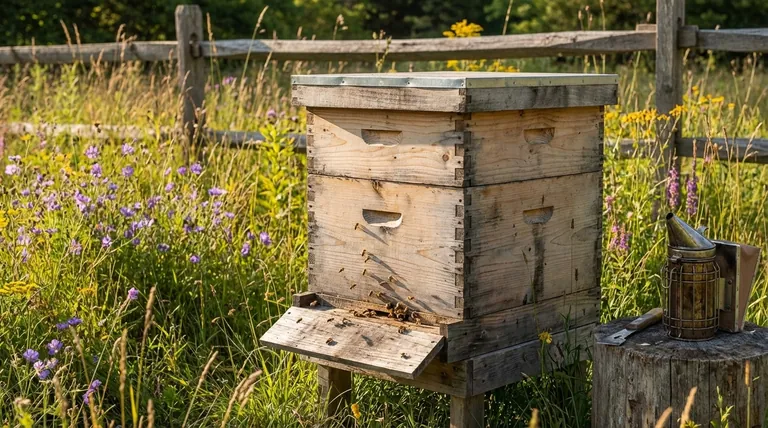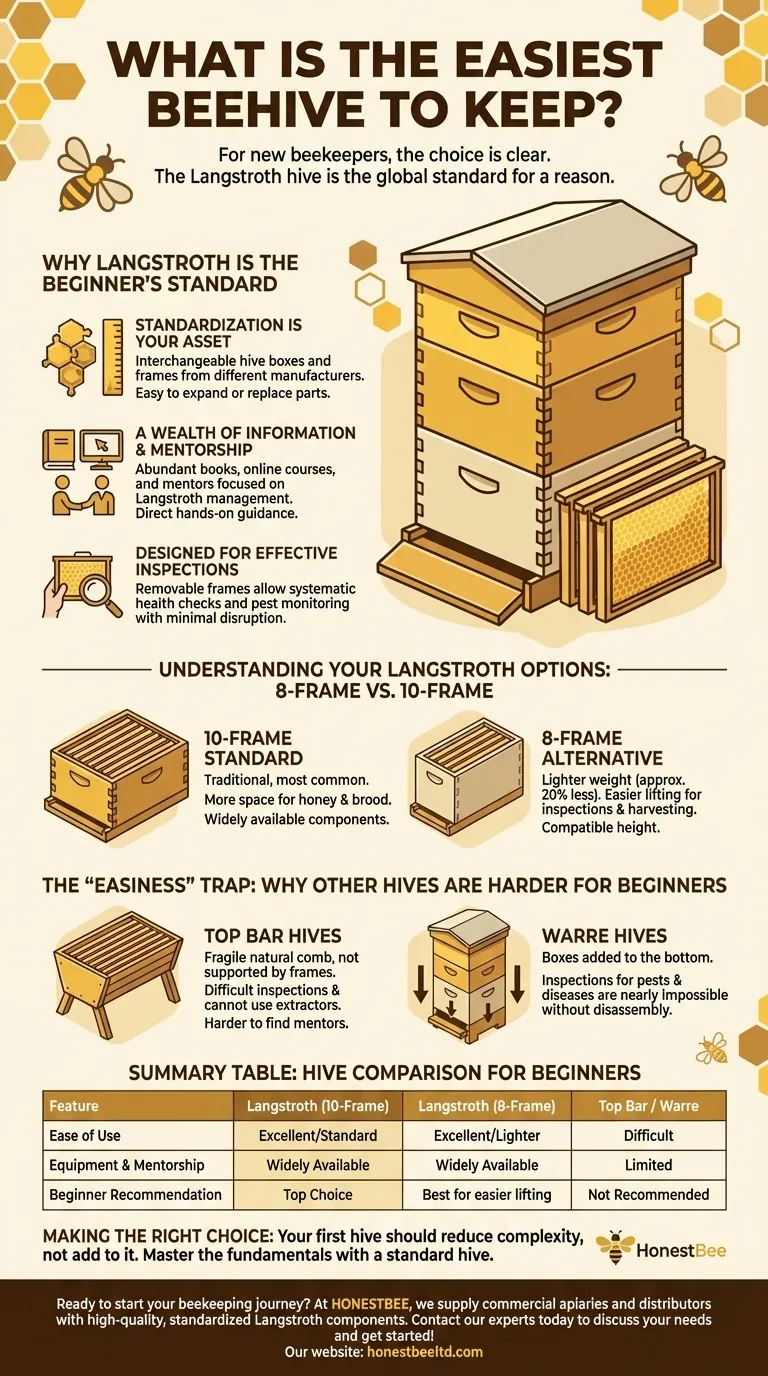For new beekeepers, the choice is clear. The easiest and most recommended beehive to start with is the Langstroth hive. This design has become the global standard, meaning the vast majority of equipment, educational resources, and mentorship opportunities are built around it. Starting with a Langstroth removes significant variables and allows you to focus on the most important part: learning to care for your bees.
The "easiest" beehive is not determined by the simplicity of its design, but by the strength of the ecosystem supporting it. The Langstroth hive's universal adoption makes it the easiest system to learn, manage, and find help for, dramatically increasing a new beekeeper's chance of success.

Why the Langstroth Hive is the Beginner's Standard
The reason experts overwhelmingly recommend the Langstroth isn't arbitrary. It's based on a century of practical application and a system designed to make bee management as straightforward as possible.
Standardization is Your Greatest Asset
A key innovation of the Langstroth hive is the concept of "bee space," which led to standardized, removable frames.
This means a hive box from one manufacturer will work with frames from another. This interchangeability is a massive advantage when you need to buy new equipment, replace a broken piece, or expand your operation.
A Wealth of Information and Mentorship
Nearly every beekeeping book, online course, and YouTube tutorial focuses on managing Langstroth hives.
When you have a question about a pest, a disease, or a behavior, you will find thousands of resources showing you exactly what to look for on a Langstroth frame. Furthermore, almost any local beekeeping club or mentor you find will be using this system, allowing them to provide direct, hands-on guidance.
Designed for Effective Inspections
Modern beekeeping requires regular inspections to monitor the colony's health, check for pests like Varroa mites, and ensure the queen is laying well.
The Langstroth's removable frames allow you to perform these inspections systematically and thoroughly with minimal disruption to the hive's structure. This is not just a convenience; it's a critical component of responsible bee husbandry.
Understanding Your Langstroth Options: 8-Frame vs. 10-Frame
Once you've settled on a Langstroth, the most common decision you'll face is whether to use 8-frame or 10-frame equipment.
The 10-Frame Standard
This is the traditional, most common configuration. A 10-frame hive offers more space for bees to store honey and raise brood.
Because it's the most popular size, you will find 10-frame components are slightly more available and sometimes less expensive than their 8-frame counterparts.
The 8-Frame Alternative
The primary advantage of an 8-frame hive is its lighter weight. A deep 10-frame box full of honey and bees can weigh 80-90 pounds, which can be a significant challenge for some people to lift.
An equivalent 8-frame box is about 20% lighter, making inspections and honey harvesting much more manageable. The components are fully compatible in height, just narrower.
The "Easiness" Trap: Why Other Hives Are Harder for Beginners
You will undoubtedly encounter other hive designs, often promoted as more "natural" or "simpler." While appealing, they introduce significant challenges that can overwhelm a new beekeeper.
Top Bar Hives
These hives look like a simple trough with wooden bars across the top. The appeal is that bees build their comb naturally without foundations.
The major drawback is that this natural comb is extremely fragile, not supported by a frame, and cannot be put in a honey extractor. Inspections are delicate, and moving combs without breakage requires significant skill. Finding a mentor for a Top Bar hive is also considerably more difficult.
Warre Hives
The Warre hive is a vertical stacking hive where new boxes are added to the bottom, not the top. The idea is to mimic a bee's natural tendency to build downward.
While this is less disruptive, it makes inspections for pests and diseases nearly impossible without completely disassembling the hive. This conflicts with the fundamental need for a beginner to easily monitor colony health.
Making the Right Choice for Your Goal
Your first hive should set you up for success by reducing complexity, not adding to it. The goal is to become a good beekeeper first, then you can experiment with different equipment.
- If your primary focus is simplicity and finding help: Choose a 10-frame Langstroth hive, as it is the undisputed industry standard for equipment, education, and mentorship.
- If you are concerned about lifting heavy weights: Choose an 8-frame Langstroth hive for more manageable boxes while still benefiting from the core Langstroth system.
- If you are drawn to "natural" beekeeping methods: Start with a Langstroth to master the fundamentals of bee biology and health first, then add a different hive type in your second or third year.
Mastering the fundamentals with a standard hive is the fastest path to becoming a confident and successful beekeeper.
Summary Table:
| Feature | Langstroth Hive (10-Frame) | Langstroth Hive (8-Frame) | Top Bar / Warre Hives |
|---|---|---|---|
| Ease of Use | Excellent (Standard) | Excellent (Lighter) | Difficult (Fragile comb, hard inspections) |
| Equipment & Mentorship | Widely Available | Widely Available | Limited |
| Beginner Recommendation | Top Choice | Best for easier lifting | Not Recommended for Beginners |
Ready to start your beekeeping journey with the right equipment?
At HONESTBEE, we supply commercial apiaries and beekeeping equipment distributors with high-quality, standardized Langstroth hive components through our wholesale-focused operations. Let us equip you for success from day one.
Contact our experts today to discuss your hive needs and get started!
Visual Guide

Related Products
- Langstroth Bee Hives Bee Keeping Box for Beginners Beekeeping
- HONESTBEE Advanced Ergonomic Stainless Steel Hive Tool for Beekeeping
- HONESTBEE Professional Multi-Functional Hive Tool with Ergonomic Wood Handle
- HONESTBEE Professional Long Handled Hive Tool with Precision Cutting Blade
- Multi-Function Plier-Style Frame Grip Hive Tool
People Also Ask
- What are the key features of the Langstroth beehive? A Guide to the Standard for Modern Beekeeping
- Should a beginner try a different type of hive? Start with a Langstroth for a solid foundation.
- What is the best type of bee hive for beginners? Start with the Proven Langstroth Standard
- Why are Langstroth hives recommended for beginners? Unmatched Support & Standardization
- Why were wooden hives traditionally preferred? For Natural Beekeeping Aligned with Bee Biology



















